Deciphering Blood Flow Restriction Training to Aid Lipid Lowering in Obese College Students through Untargeted Metabolomics
Abstract
1. Introduction
2. Materials and Methods
2.1. Study Subjects and Procedure
2.2. Study Design
2.3. Body Composition Test
2.4. Maximum Oxygen Uptake Test
2.5. Sample Collection and Processing
2.6. Lipolytic Agent Test
2.7. Non-Targeted Metabolomics Testing
2.7.1. Metabolic Sample Processing
2.7.2. Detection and Analysis of Metabolic Samples
2.7.3. Visualisation Method
2.8. Data Analysis
3. Results
3.1. Comparison of the Effects of Three Forms of Exercise on the Levels of Different Lipolytic Agents
3.1.1. Comparison of EPI Levels before and after Exercise in MICT, HIIT, and MICT+BFR Groups
3.1.2. Comparison of NA Levels before and after Exercise in MICT, HIIT, and MICT+BFR Groups
3.1.3. Comparison of GH Levels before and after Exercise in MICT, HIIT, and MICT+BFR Groups
3.1.4. Comparison of IL-6 Levels before and after Exercise in MICT, HIIT, and MICT+BFR Groups
3.2. Metabolomic Analysis of MICT and MICT+BFR
3.2.1. Comparison of Metabolic Characteristics before and after Exercise in MICT Group
3.2.2. Comparison of Metabolic Characteristics before and after Exercise in MICT+BFR Group
3.2.3. Comparison of Pre-Exercise Metabolic Characteristics between MICT Group and MICT+BFR Group before Exercise
3.2.4. Post-Exercise Metabolic Characteristics of the MICT Group Compared to the MICT+BFR Group after Exercise
4. Discussion
5. Conclusions
Supplementary Materials
Author Contributions
Funding
Institutional Review Board Statement
Informed Consent Statement
Data Availability Statement
Acknowledgments
Conflicts of Interest
References
- Jastreboff, A.M.; Kotz, C.M.; Kahan, S.; Kelly, A.S.; Heymsfield, S.B. Obesity as a Disease: The Obesity Society 2018 Position Statement. Obesity 2019, 27, 7–9. [Google Scholar] [CrossRef]
- Smith, K.B.; Smith, M.S. Obesity Statistics. Primary Care 2016, 43, 121–135. [Google Scholar] [CrossRef] [PubMed]
- Arroyo-Johnson, C.; Mincey, K.D. Obesity Epidemiology Worldwide. Gastroenterol. Clin. N. Am. 2016, 45, 571–579. [Google Scholar] [CrossRef] [PubMed]
- Chen, Y.; Peng, Q.; Yang, Y.; Zheng, S.; Wang, Y.; Lu, W. The Prevalence and Increasing Trends of Overweight, General Obesity, and Abdominal Obesity among Chinese Adults: A Repeated Cross-Sectional Study. BMC Public Health 2019, 19, 1293. [Google Scholar] [CrossRef] [PubMed]
- Ogden, C.L.; Fryar, C.D.; Hales, C.M.; Carroll, M.D.; Aoki, Y.; Freedman, D.S. Differences in Obesity Prevalence by Demographics and Urbanization in US Children and Adolescents, 2013-2016. JAMA-J. Am. Med. Assoc. 2018, 319, 2410–2418. [Google Scholar] [CrossRef] [PubMed]
- Lipson, S.K.; Sonneville, K.R. Eating Disorder Symptoms among Undergraduate and Graduate Students at 12 US Colleges and Universities. Eat. Behav. 2017, 24, 81–88. [Google Scholar] [CrossRef]
- Duan, H.; Gong, M.; Zhang, Q.; Huang, X.; Wan, B. Research on Sleep Status, Body Mass Index, Anxiety and Depression of College Students during the Post-Pandemic Era in Wuhan, China. J. Affect. Disord. 2022, 301, 189–192. [Google Scholar] [CrossRef]
- Tomiyama, A.J.; Carr, D.; Granberg, E.M.; Major, B.; Robinson, E.; Sutin, A.R.; Brewis, A. How and Why Weight Stigma Drives the Obesity “epidemic” and Harms Health. BMC Med. 2018, 16, 123. [Google Scholar] [CrossRef] [PubMed]
- Alizadeh Pahlavani, H. Exercise Therapy for People With Sarcopenic Obesity: Myokines and Adipokines as Effective Actors. Front. Endocrinol. 2022, 13, 811751. [Google Scholar] [CrossRef]
- Carbone, S.; Del Buono, M.G.; Ozemek, C.; Lavie, C.J. Obesity, Risk of Diabetes and Role of Physical Activity, Exercise Training and Cardiorespiratory Fitness. Prog. Cardiovasc. Dis. 2019, 62, 327–333. [Google Scholar] [CrossRef]
- Wewege, M.; van den Berg, R.; Ward, R.E.; Keech, A. The Effects of High-Intensity Interval Training vs. Moderate-Intensity Continuous Training on Body Composition in Overweight and Obese Adults: A Systematic Review and Meta-Analysis. Obes. Rev. 2017, 18, 635–646. [Google Scholar] [CrossRef] [PubMed]
- Batacan, R.B.; Duncan, M.J.; Dalbo, V.J.; Tucker, P.S.; Fenning, A.S. Effects of High-Intensity Interval Training on Cardiometabolic Health: A Systematic Review and Meta-Analysis of Intervention Studies. Br. J. Sports Med. 2017, 51, 494–503. [Google Scholar] [CrossRef] [PubMed]
- Ghaith, A.; Chacaroun, S.; Borowik, A.; Chatel, L.; Doutreleau, S.; Wuyam, B.; Tamisier, R.; Pepin, J.-L.; Flore, P.; Verges, S. Hypoxic High-Intensity Interval Training in Individuals with Overweight and Obesity. Am. J. Physiol.-Regul. Integr. Comp. Physiol. 2022, 323, R700–R709. [Google Scholar] [CrossRef] [PubMed]
- Ren, J.; Wu, N.N.; Wang, S.; Sowers, J.R.; Zhang, Y. Obesity Cardiomyopathy: Evidence, Mechanisms, and Therapeutic Implications. Physiol. Rev. 2021, 101, 1745–1807. [Google Scholar] [CrossRef] [PubMed]
- Gomes Silva, J.C.; Pereira Neto, E.A.; Souza Pfeiffer, P.A.; Rodrigues Neto, G.; Rodrigues, A.S.; Bemben, M.G.; Patterson, S.D.; Batista, G.R.; Cirilo-Sousa, M.S. Acute and Chronic Responses of Aerobic Exercise With Blood Flow Restriction: A Systematic Review. Front. Physiol. 2019, 10, 1239. [Google Scholar] [CrossRef]
- Brown, J.; Lauver, J.D.; Guilkey, J.P. Cardiovascular Responses To Aerobic Exercise With Continuous And Discontinuous Blood Flow Restriction. Med. Sci. Sports Exerc. 2022, 54, 350–351. [Google Scholar] [CrossRef]
- Angelopoulos, P.; Tsekoura, M.; Mylonas, K.; Tsigkas, G.; Billis, E.; Tsepis, E.; Fousekis, K. The Effectiveness of Blood Flow Restriction Training in Cardiovascular Disease Patients: A Scoping Review. J. Frailty Sarcopenia Falls 2023, 8, 107–117. [Google Scholar] [CrossRef] [PubMed]
- Smith, N.D.W.; Scott, B.R.R.; Girard, O.; Peiffer, J.J.J. Aerobic Training With Blood Flow Restriction for Endurance Athletes: Potential Benefits and Considerations of Implementation. J. Strength Cond. Res. 2022, 36, 3541–3550. [Google Scholar] [CrossRef]
- Kim, Y.A.; Keogh, J.B.; Clifton, P.M. Probiotics, Prebiotics, Synbiotics and Insulin Sensitivity. Nutr. Res. Rev. 2018, 31, 35–51. [Google Scholar] [CrossRef]
- Zhang, L.-X.; Li, C.-X.; Kakar, M.U.; Khan, M.S.; Wu, P.-F.; Amir, R.M.; Dai, D.-F.; Naveed, M.; Li, Q.-Y.; Saeed, M.; et al. Resveratrol (RV): A Pharmacological Review and Call for Further Research. Biomed. Pharmacother. 2021, 143, 112164. [Google Scholar] [CrossRef]
- Sun, Q.; Xu, Q.; Wang, M.; Wang, Y.; Zhang, D.; Lai, M. OpenNAU: An Open-Source Platform for Normalizing, Analyzing, and Visualizing Cancer Untargeted Metabolomics Data. Chin. J. Cancer Res. 2023, 35, 550–562. [Google Scholar] [CrossRef] [PubMed]
- Dogan, H.O. Metabolomics: A Review of Liquid Chromatography Mass Spectrometry-Based Methods and Clinical Applications. Turk. J. Biochem. 2024, 49, 1–14. [Google Scholar] [CrossRef]
- Berge, J.; Hjelmesaeth, J.; Hertel, J.K.; Gjevestad, E.; Smastuen, M.C.; Johnson, L.K.; Martins, C.; Andersen, E.; Helgerud, J.; Storen, O. Effect of Aerobic Exercise Intensity on Energy Expenditure and Weight Loss in Severe Obesity-A Randomized Controlled Trial. Obesity 2021, 29, 359–369. [Google Scholar] [CrossRef]
- Wu, H.C.; Wang, M.J.J. Determining the Maximum Acceptable Work Duration for High-Intensity Work. Eur. J. Appl. Physiol. 2001, 85, 339–344. [Google Scholar] [CrossRef]
- Jamnick, N.A.; Pettitt, R.W.; Granata, C.; Pyne, D.B.; Bishop, D.J. An Examination and Critique of Current Methods to Determine Exercise Intensity. Sports Med. 2020, 50, 1729–1756. [Google Scholar] [CrossRef]
- Morishima, T.; Ochi, E. Impact of a Single Bout of Resistance Exercise on Serum Klotho in Healthy Young Men. Physiol. Rep. 2021, 9, e15087. [Google Scholar] [CrossRef]
- Sellrie, F.; Schenk, J.A.; Behrsing, O.; Böttger, V.; Micheel, B. A Competitive Immunoassay to Detect a Hapten Using an Enzyme-Labelled Peptide Mimotope as Tracer. J. Immunol. Methods 2002, 261, 141–144. [Google Scholar] [CrossRef]
- Kohl, T.O.; Ascoli, C.A. Immunometric Double-Antibody Sandwich Enzyme-Linked Immunosorbent Assay. Cold Spring Harb. Protoc. 2017, 2017. [Google Scholar] [CrossRef] [PubMed]
- Laboratory Mixer Mill MM 400—RETSCH. Available online: https://www.retsch.com/products/milling/ball-mills/mixer-mill-mm-400/ (accessed on 9 July 2024).
- Seger, C.; Salzmann, L. After Another Decade: LC-MS/MS Became Routine in Clinical Diagnostics. Clin. Biochem. 2020, 82, 2–11. [Google Scholar] [CrossRef] [PubMed]
- Bazzano, C.F.; de Felicio, R.; Alves, L.F.G.; Costa, J.H.; Ortega, R.; Vieira, B.D.; Morais-Urano, R.P.; Furtado, L.C.; Ferreira, E.L.F.; Gubiani, J.R.; et al. NP3 MS Workflow: An Open-Source Software System to Empower Natural Product-Based Drug Discovery Using Untargeted Metabolomics. Anal. Chem. 2024, 96, 7460–7469. [Google Scholar] [CrossRef]
- Ribbenstedt, A.; Ziarrusta, H.; Benskin, J.P. Development, Characterization and Comparisons of Targeted and Non-Targeted Metabolomics Methods. PLoS ONE 2018, 13, e0207082. [Google Scholar] [CrossRef] [PubMed]
- De los Santos, S.; Mauricio Coral-Vazquez, R.; Menjivar, M.; de los Angeles Granados-Silvestre, M.; De la Rosa, S.; Antonio Reyes-Castro, L.; Pablo Mendez, J.; Zambrano, E.; Canto, P. (−)-Epicatechin Improves Body Composition of Male Rats Descendant of Obese Mothers Postnatally Fed with a High-Fat Diet. Fundam. Clin. Pharmacol. 2022, 36, 526–535. [Google Scholar] [CrossRef]
- Rabadan-Chavez, G.; Quevedo-Corona, L.; Miliar Garcia, A.; Reyes-Maldonado, E.; Eugenia Jaramillo-Flores, M. Cocoa Powder, Cocoa Extract and Epicatechin Attenuate Hypercaloric Diet-Induced Obesity through Enhanced β-Oxidation and Energy Expenditure in White Adipose Tissue. J. Funct. Food. 2016, 20, 54–67. [Google Scholar] [CrossRef]
- Maharjan, B.R.; Martinez-Huenchullan, S.F.; Mclennan, S.; Twigg, S.M.; Williams, P.F. Exercise Induces Favorable Metabolic Changes in White Adipose Tissue Preventing High-Fat Diet Obesity. Physiol. Rep. 2021, 9, e14929. [Google Scholar] [CrossRef] [PubMed]
- Watson, F.; Taylor, A.; Rayner, M.; Lobstein, T.; Hinks, R. Priority Actions for Addressing the Obesity Epidemic in England. Public Health Nutr. 2018, 21, 1002–1010. [Google Scholar] [CrossRef]
- Gao, Y. Effects of Exercise on Oxidative Stress and Related Factors of Obese Young Women. Acta Med. Mediterr. 2016, 32, 563–566. [Google Scholar]
- Huang, Z.; Huang, L.; Waters, M.J.; Chen, C. Insulin and Growth Hormone Balance: Implications for Obesity. Trends Endocrinol. Metab. 2020, 31, 642–654. [Google Scholar] [CrossRef] [PubMed]
- Lauterio, T.J.; Barkan, R.; DeAngelo, M.; DeMott-Friberg, R.; Ramirez, R. Plasma Growth Hormone Secretion Is Impaired in Obesity-Prone Rats before Onset of Diet-Induced Obesity. Am. J. Physiol.-Endocrinol. Metab. 1998, 275, E6–E11. [Google Scholar] [CrossRef] [PubMed]
- Li, X.; Zhou, B.; Yao, Y.; Wang, G.; Meng, H. Reduced Growth Hormone Predicts Worsening Adipose Tissue Insulin Resistance in Adults with Obesity. Obes. Facts 2023, 16, 401–410. [Google Scholar] [CrossRef]
- Hejla, D.; Dror, N.; Pantanowitz, M.; Nemet, D.; Eliakim, A. Reduced Growth Hormone Response to Anaerobic Exercise Among Children With Overweight and Obesity. J. Strength Cond. Res. 2022, 36, 2194–2197. [Google Scholar] [CrossRef]
- Mauer, J.; Chaurasia, B.; Goldau, J.; Vogt, M.C.; Ruud, J.; Nguyen, K.D.; Theurich, S.; Hausen, A.C.; Schmitz, J.; Broenneke, H.S.; et al. Signaling by IL-6 Promotes Alternative Activation of Macrophages to Limit Endotoxemia and Obesity-Associated Resistance to Insulin. Nat. Immunol. 2014, 15, 423–430. [Google Scholar] [CrossRef] [PubMed]
- Hirano, T. IL-6 in Inflammation, Autoimmunity and Cancer. Int. Immunol. 2021, 33, 127–148. [Google Scholar] [CrossRef] [PubMed]
- Kalra, S.; Mandlekar, A.; Kapoor, N. Exercise Therapy for the Exercise Naive: The First Step in Obesity Management. J. Pak. Med. Assoc. 2021, 71, 2828–2830. [Google Scholar] [PubMed]
- Guerra Gomez, E.; Zambrano-Enriquez Ganzolfo, D.; Eaton Iturbide, K.; Unzeta Conde, B.; Vilarino Besteiro, P.; Perez Franco, C.; Meson de Arana, P.; Banos Martin, I. Scientific Bases That Support the Relation between TCA and Obesity: A Systematic Review. Psychother. Psychosom. 2015, 84, 28. [Google Scholar]
- Rangel-Huerta, O.D.; Pastor-Villaescusa, B.; Gil, A. Are We Close to Defining a Metabolomic Signature of Human Obesity? A Systematic Review of Metabolomics Studies. Metabolomics 2019, 15, 93. [Google Scholar] [CrossRef]
- Zhang, A.; Sun, H.; Wang, X. Emerging Role and Recent Applications of Metabolomics Biomarkers in Obesity Disease Research. RSC Adv. 2017, 7, 14966–14973. [Google Scholar] [CrossRef]
- Newgard, C.B. Metabolomics and Metabolic Diseases: Where Do We Stand? Cell Metab. 2017, 25, 43–56. [Google Scholar] [CrossRef] [PubMed]
- Gonzalez-Covarrubias, V.; Martinez-Martinez, E.; del Bosque-Plata, L. The Potential of Metabolomics in Biomedical Applications. Metabolites 2022, 12, 194. [Google Scholar] [CrossRef] [PubMed]
- Coppola, S.; Avagliano, C.; Calignano, A.; Berni Canani, R. The Protective Role of Butyrate against Obesity and Obesity-Related Diseases. Molecules 2021, 26, 682. [Google Scholar] [CrossRef]
- Rogero, M.M.; Calder, P.C. Obesity, Inflammation, Toll-Like Receptor 4 and Fatty Acids. Nutrients 2018, 10, 432. [Google Scholar] [CrossRef]
- Alves, A.; Bassot, A.; Bulteau, A.-L.; Pirola, L.; Morio, B. Glycine Metabolism and Its Alterations in Obesity and Metabolic Diseases. Nutrients 2019, 11, 1356. [Google Scholar] [CrossRef] [PubMed]
- Inigo, M.; Deja, S.; Burgess, S.C. Ins and Outs of the TCA Cycle: The Central Role of Anaplerosis. In Annual Review of Nutrition; Stover, P.J., Balling, R., Eds.; Annual Reviews: Palo Alto, CA, USA, 2021; Volume 41, pp. 19–47. ISBN 978-0-8243-2841-2. [Google Scholar]
- Satapati, S.; Sunny, N.E.; Kucejova, B.; Fu, X.; He, T.T.; Mendez-Lucas, A.; Shelton, J.M.; Perales, J.C.; Browning, J.D.; Burgess, S.C. Elevated TCA Cycle Function in the Pathology of Diet-Induced Hepatic Insulin Resistance and Fatty Liver. J. Lipid Res. 2012, 53, 1080–1092. [Google Scholar] [CrossRef] [PubMed]
- Xiong, Y.; Luan, Y.; Yuan, L.; Hong, W.; Wang, B.; Zhao, H.; Zhang, B. Aerobic Exercise Attenuates High-Fat Diet-Induced Renal Injury through Kidney Metabolite Modulation in Mice. Ren. Fail. 2024, 46, 2286330. [Google Scholar] [CrossRef] [PubMed]
- Siopi, A.; Deda, O.; Manou, V.; Kellis, S.; Kosmidis, I.; Komninou, D.; Raikos, N.; Christoulas, K.; Theodoridis, G.A.; Mougios, V. Effects of Different Exercise Modes on the Urinary Metabolic Fingerprint of Men with and without Metabolic Syndrome. Metabolites 2017, 7, 5. [Google Scholar] [CrossRef] [PubMed]
- Hahn, A.K.; Batushansky, A.; Rawle, R.A.; Lopes, E.B.P.; June, R.K.; Griffin, T.M. Effects of Long-Term Exercise and a High-Fat Diet on Synovial Fluid Metabolomics and Joint Structural Phenotypes in Mice: An Integrated Network Analysis. Osteoarthr. Cartil. 2021, 29, 1549–1563. [Google Scholar] [CrossRef] [PubMed]
- Grapov, D.; Fiehn, O.; Campbell, C.; Chandler, C.J.; Burnett, D.J.; Souza, E.C.; Casazza, G.A.; Keim, N.L.; Newman, J.W.; Hunter, G.R.; et al. Exercise Plasma Metabolomics and Xenometabolomics in Obese, Sedentary, Insulin-Resistant Women: Impact of a Fitness and Weight Loss Intervention (Vol 317, E999, 2019). Am. J. Physiol.-Endocrinol. Metab. 2020, 319, E458. [Google Scholar] [CrossRef]
- Wang, R.; Guo, S.; Lian, H.; Huang, Y.; Yang, Q.; Zhao, K.; Kuo, C.-H.; Hong, S.; Chen, P.; Liu, T. Hypoxic Training in Obese Mice Improves Metabolic Disorder. Front. Endocrinol. 2019, 10, 527. [Google Scholar] [CrossRef]
- Duft, R.G.; Castro, A.; Bonfante, I.L.P.; Brunelli, D.T.; Chacon-Mikahil, M.P.T.; Cavaglieri, C.R. Metabolomics Approach in the Investigation of Metabolic Changes in Obese Men after 24 Weeks of Combined Training. J. Proteome Res. 2017, 16, 2151–2159. [Google Scholar] [CrossRef] [PubMed]
- Khoramipour, K.; Sandbakk, O.; Keshteli, A.H.; Gaeini, A.A.; Wishart, D.S.; Chamari, K. Metabolomics in Exercise and Sports: A Systematic Review. Sports Med. 2022, 52, 547–583. [Google Scholar] [CrossRef]
- Lv, Z.; Gong, Z.-G.; Xu, Y.-J. Research in the Field of Exercise and Metabolomics: A Bibliometric and Visual Analysis. Metabolites 2022, 12, 542. [Google Scholar] [CrossRef]
- Ammar, N.M.; Farag, M.A.; Kholeif, T.E.; Metwally, N.S.; El-Sheikh, N.M.; El Gendy, A.N.; Abdel-Hamid, A.-H.Z. Serum Metabolomics Reveals the Mechanistic Role of Functional Foods and Exercise for Obesity Management in Rats. J. Pharm. Biomed. Anal. 2017, 142, 91–101. [Google Scholar] [CrossRef] [PubMed]
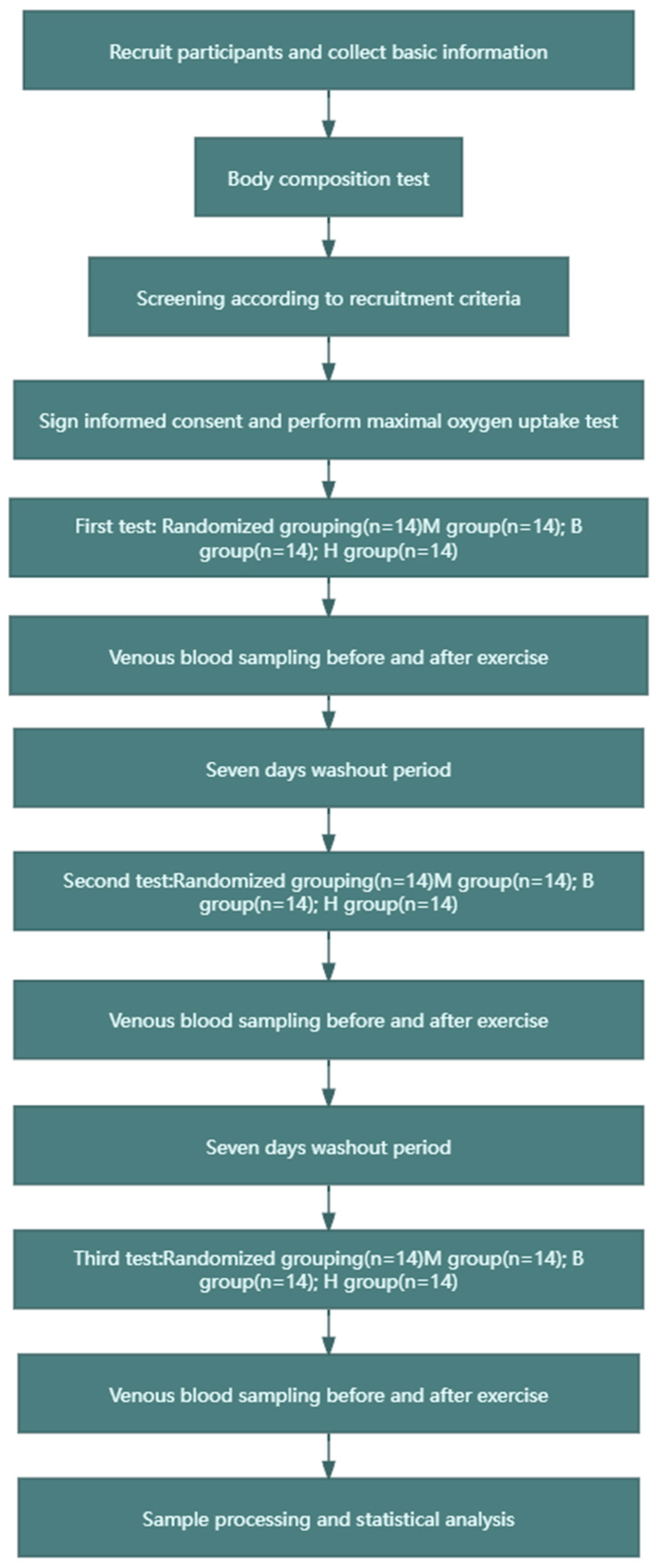
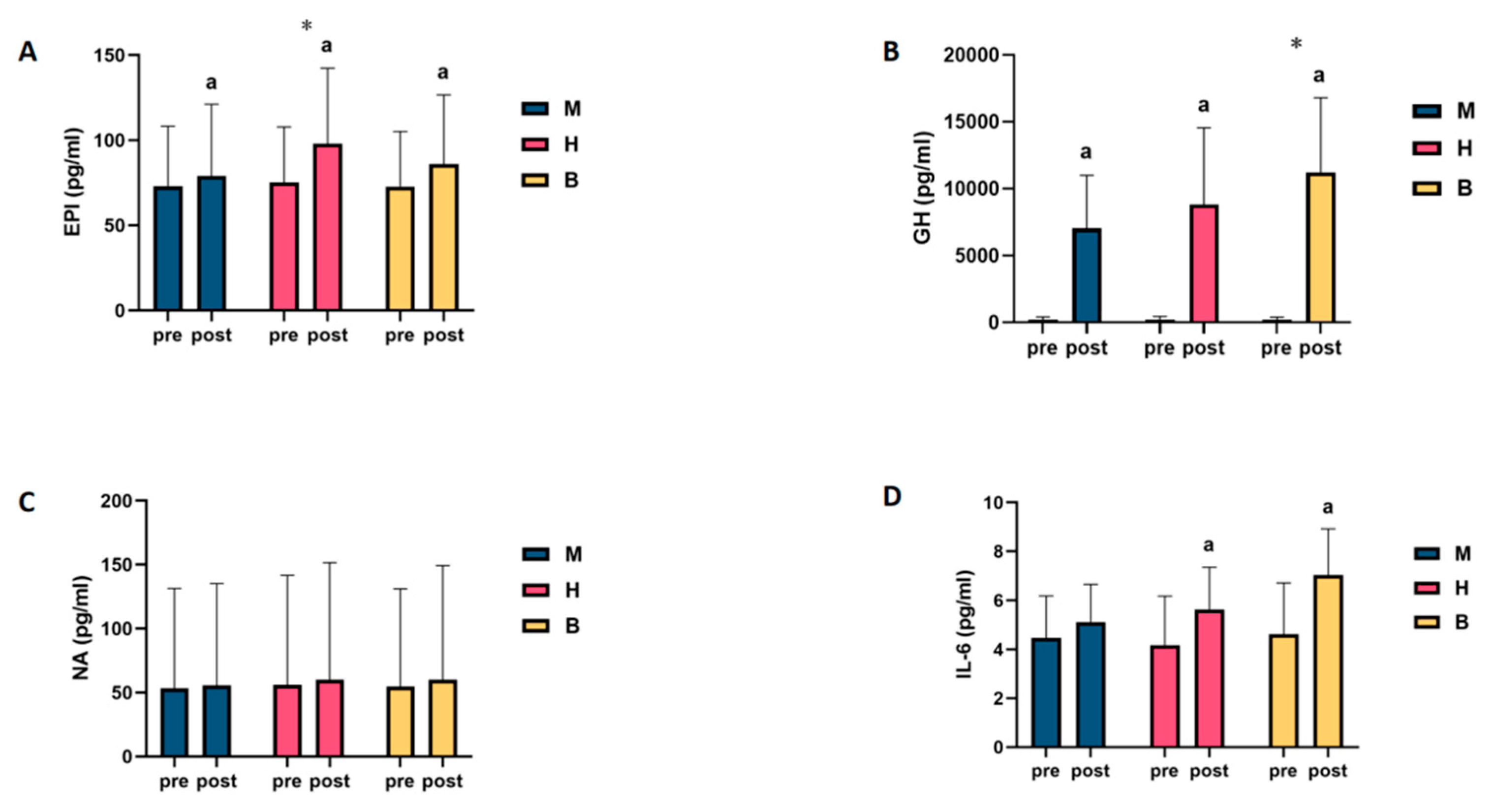
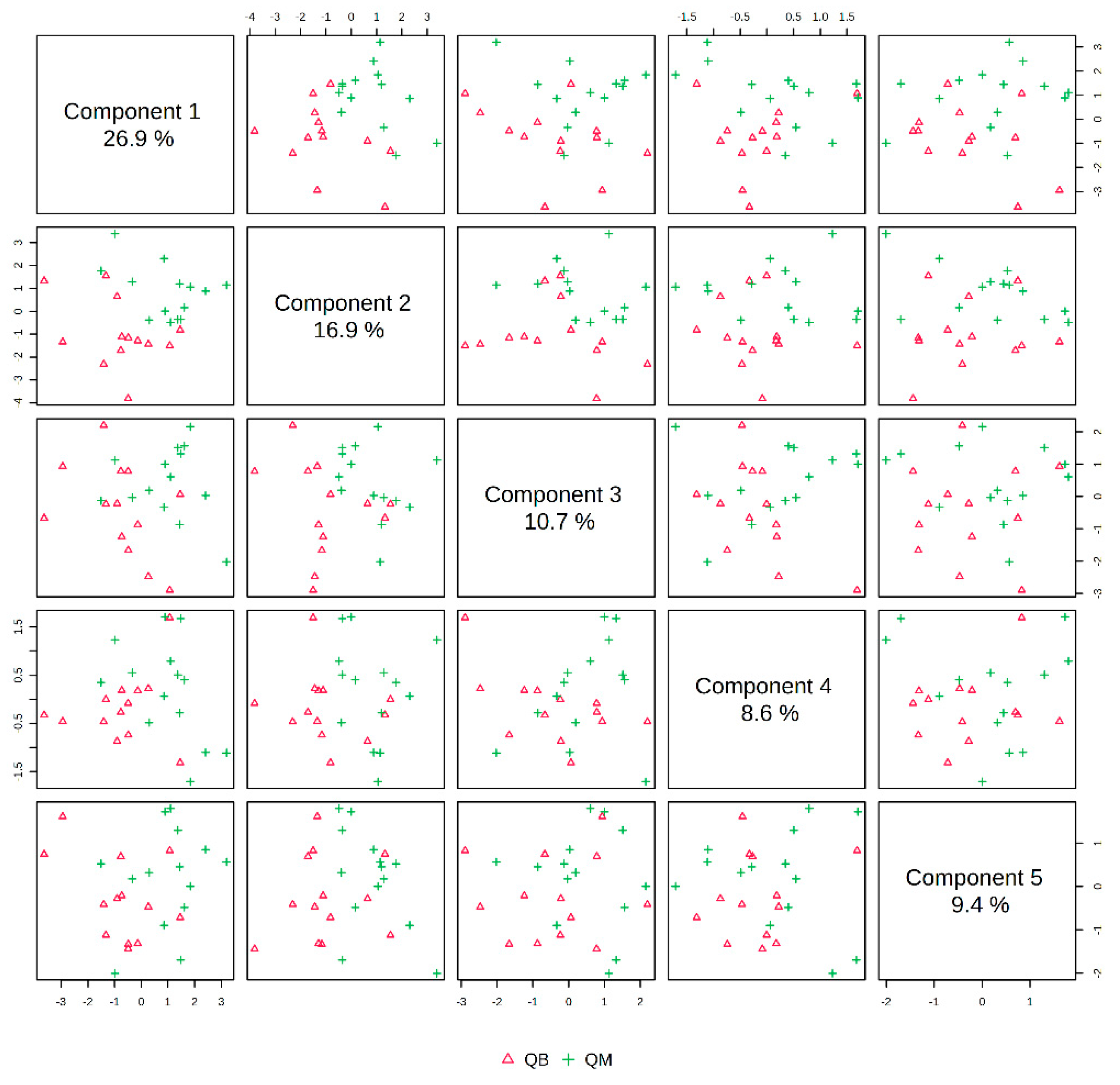
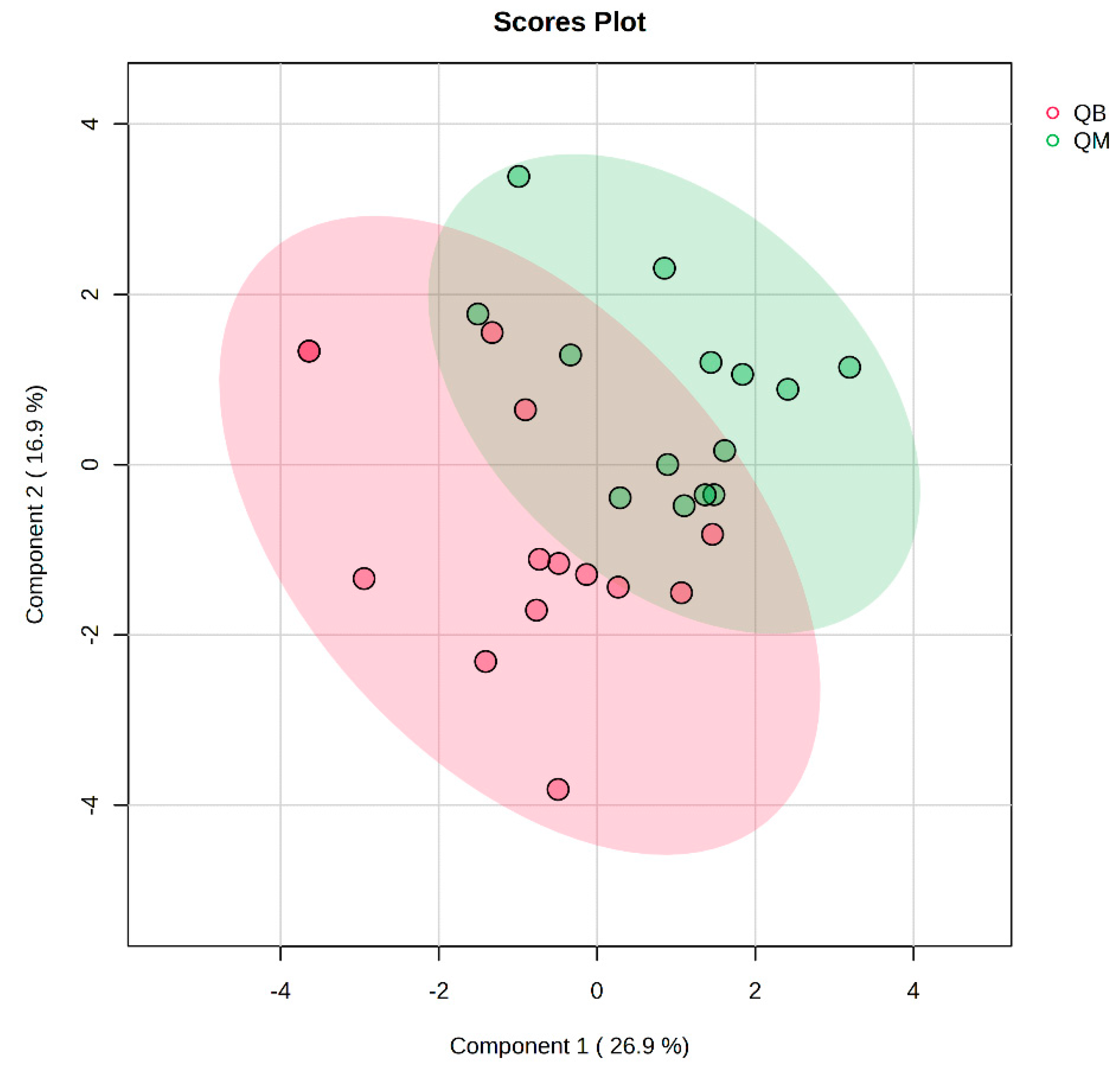
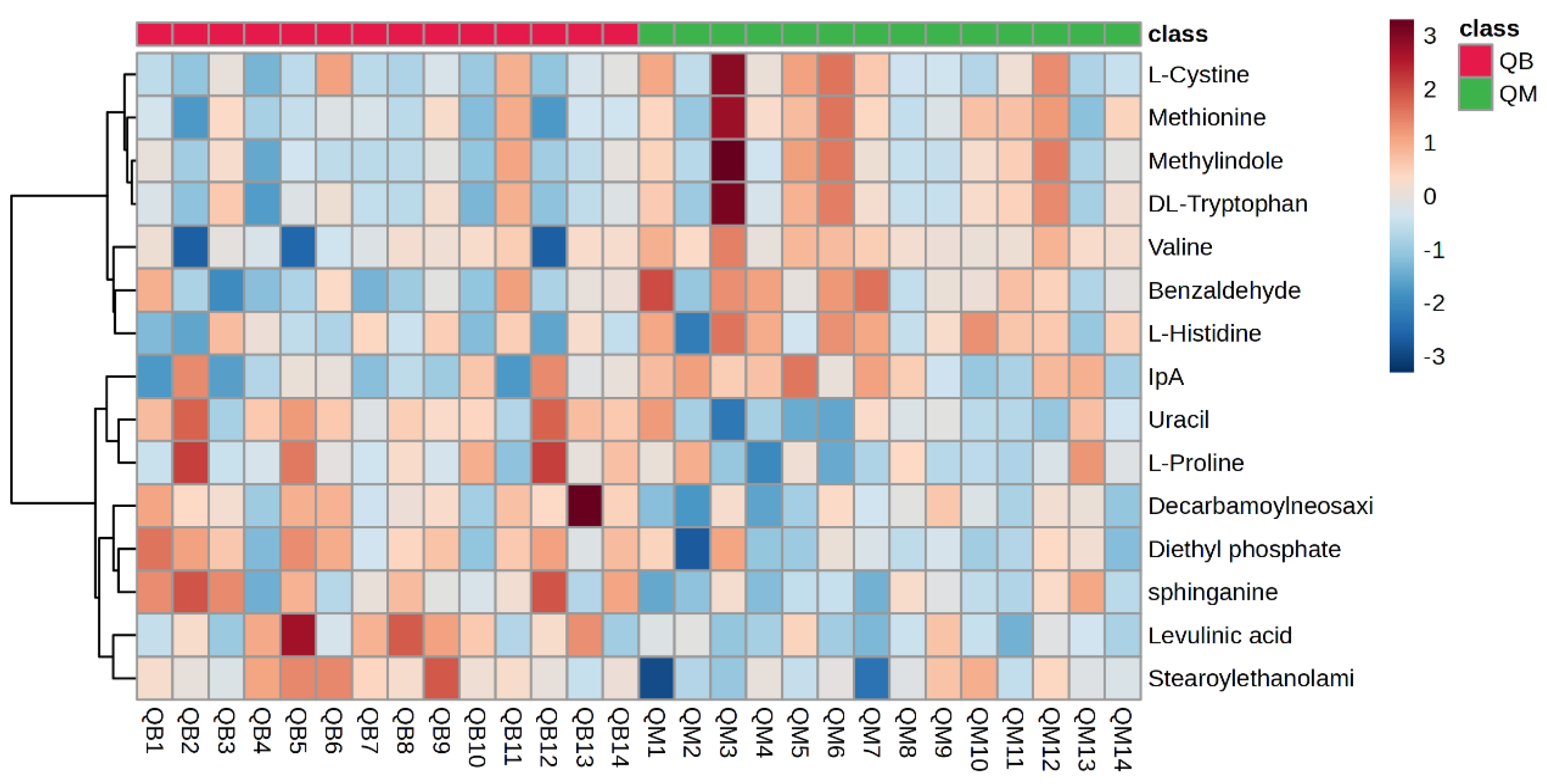
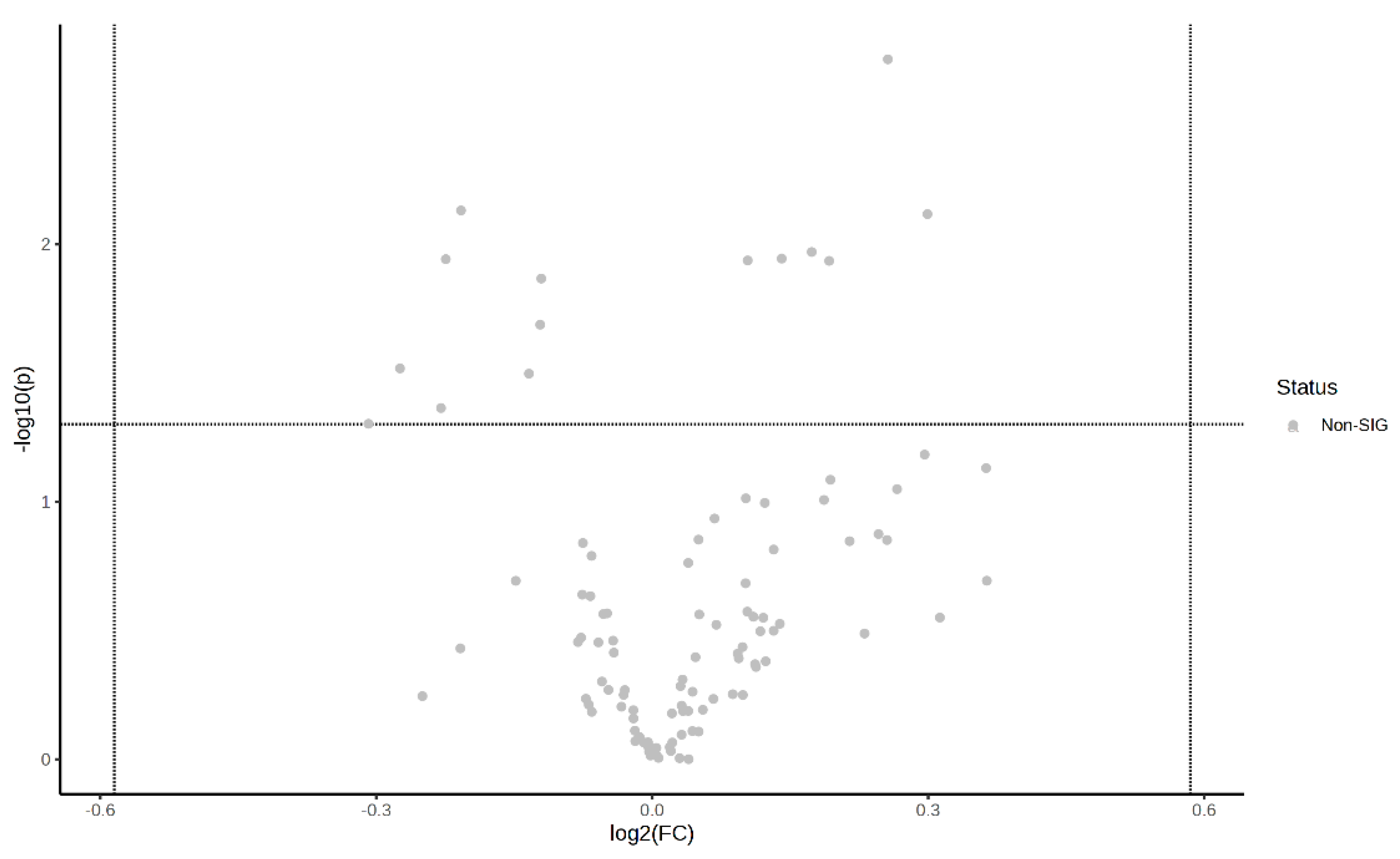
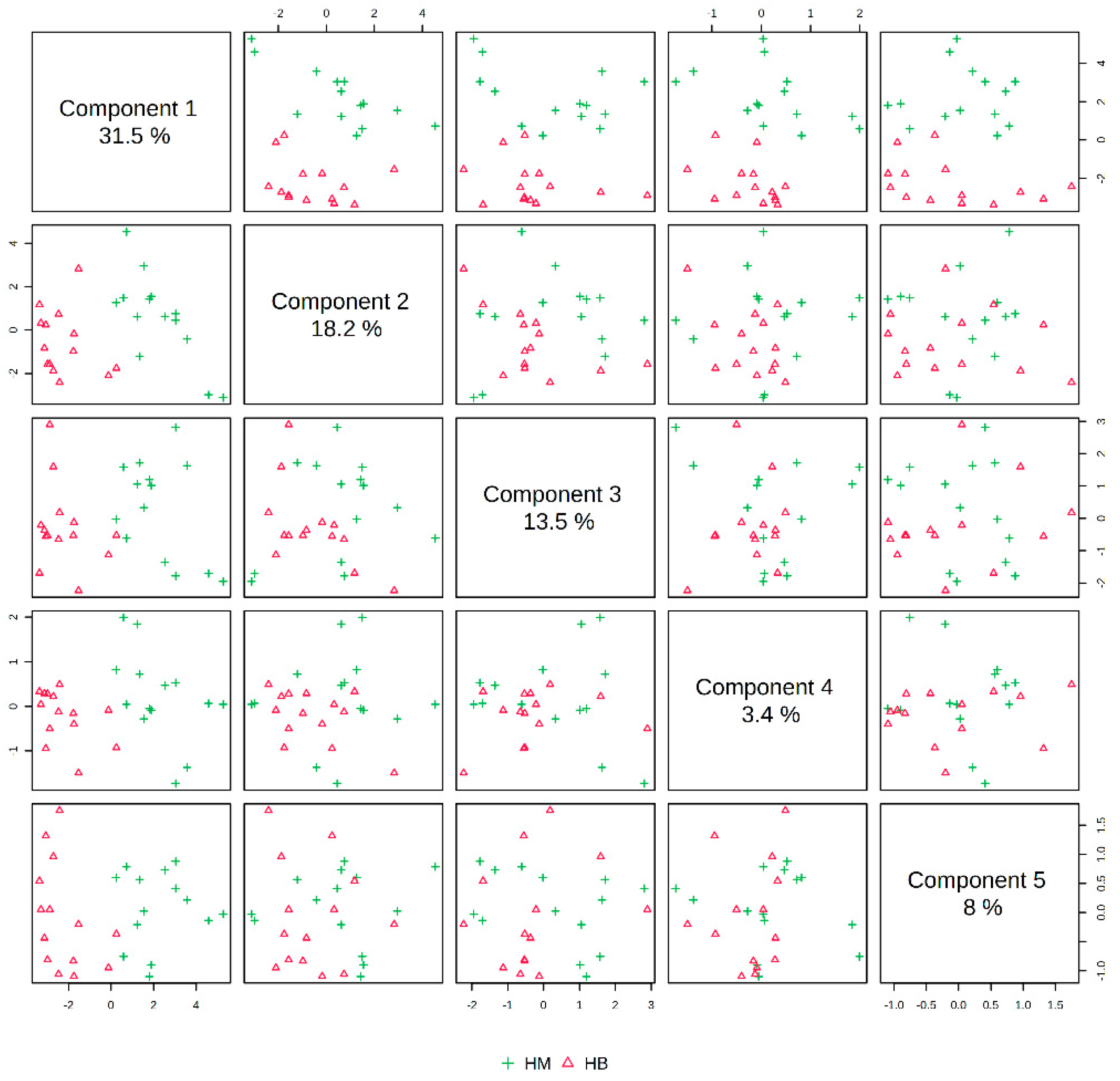
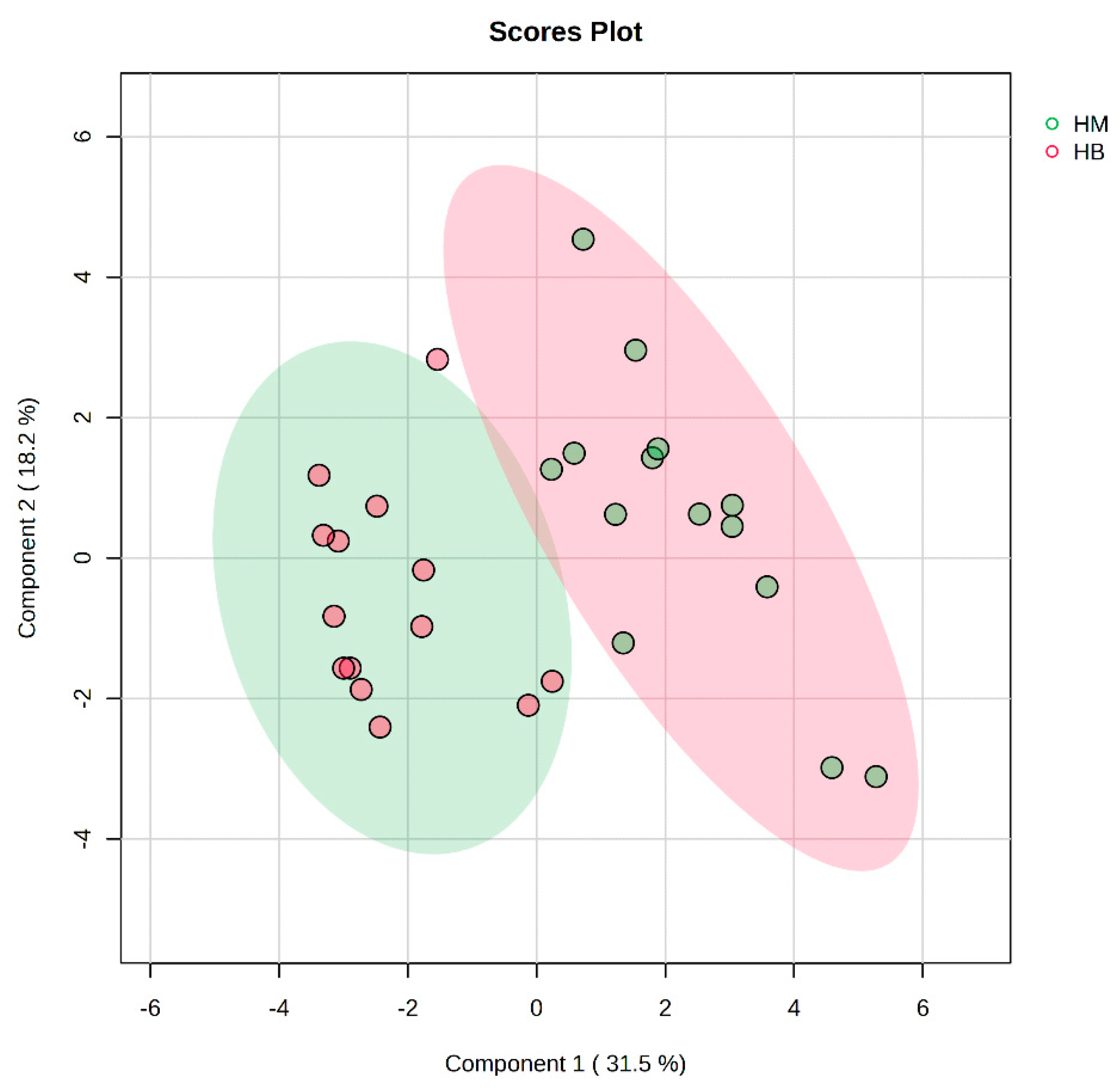
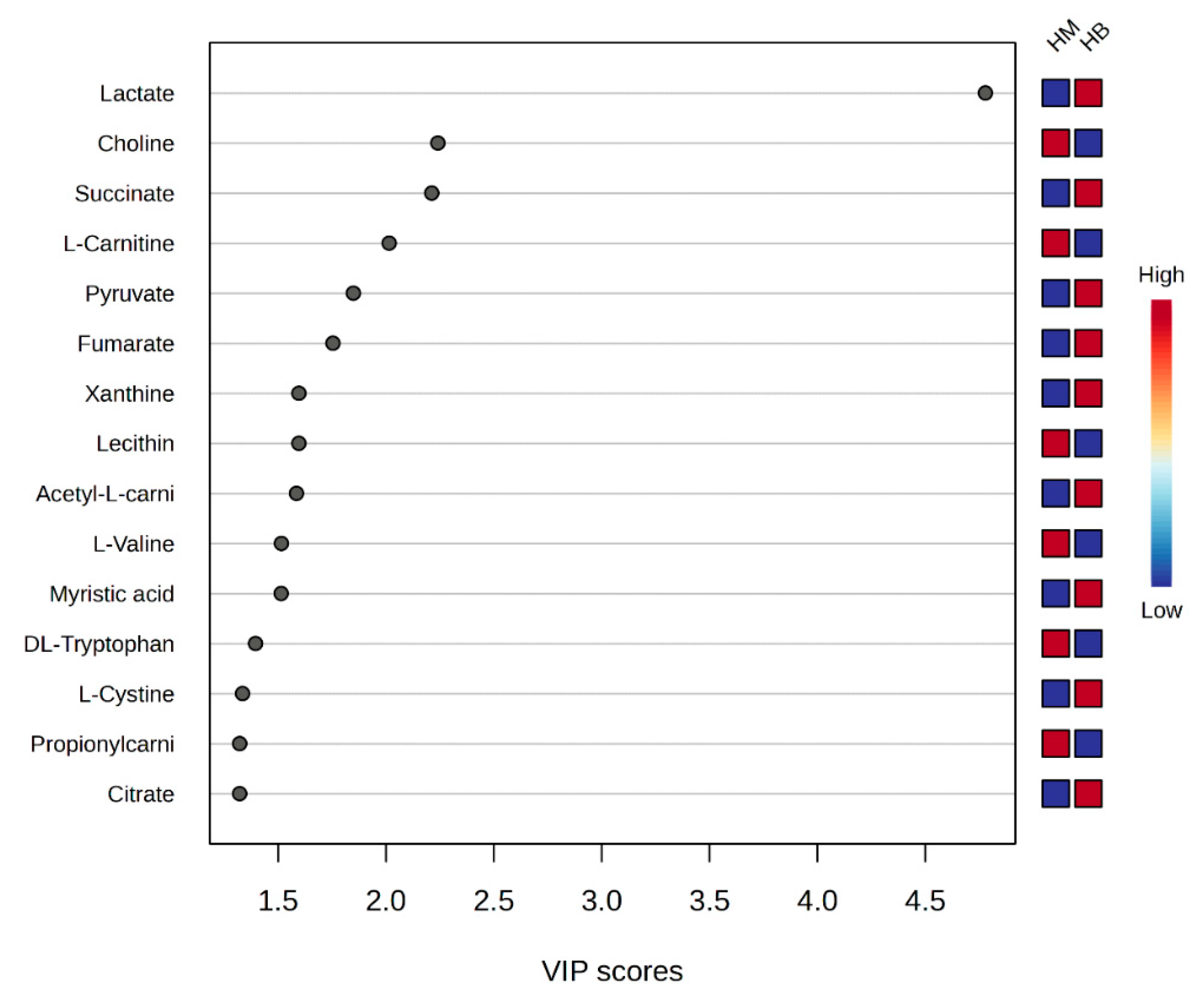
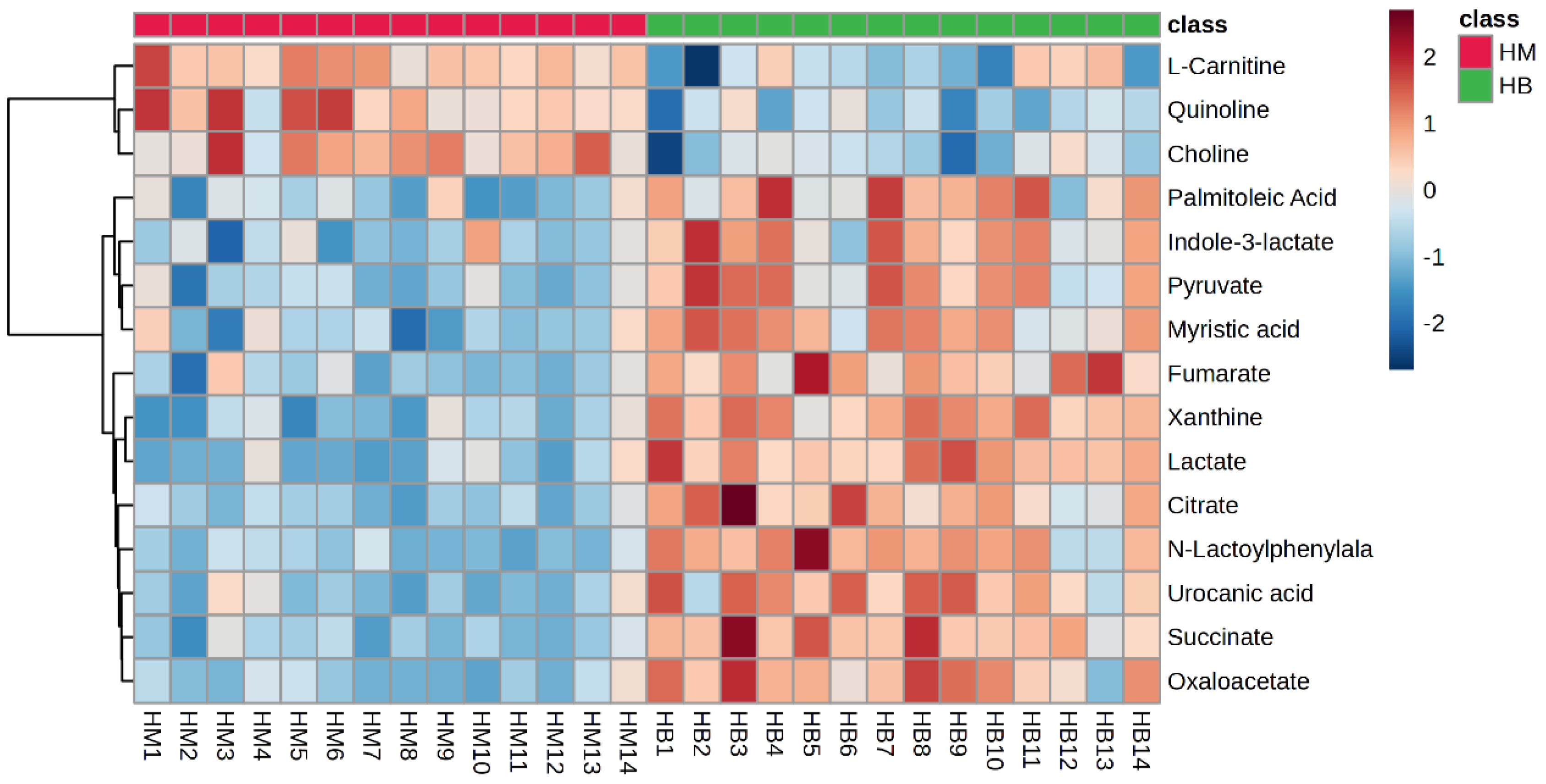
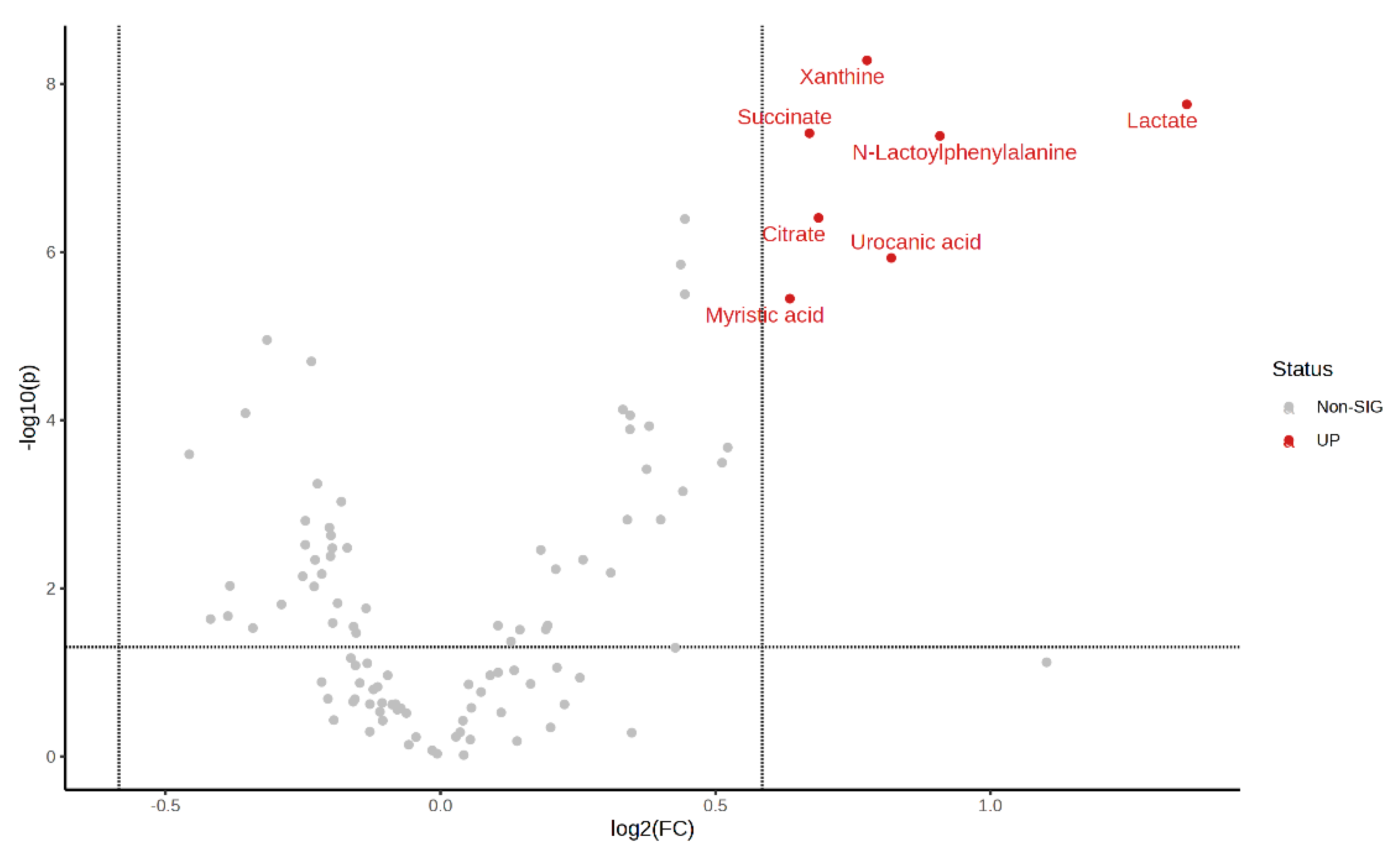
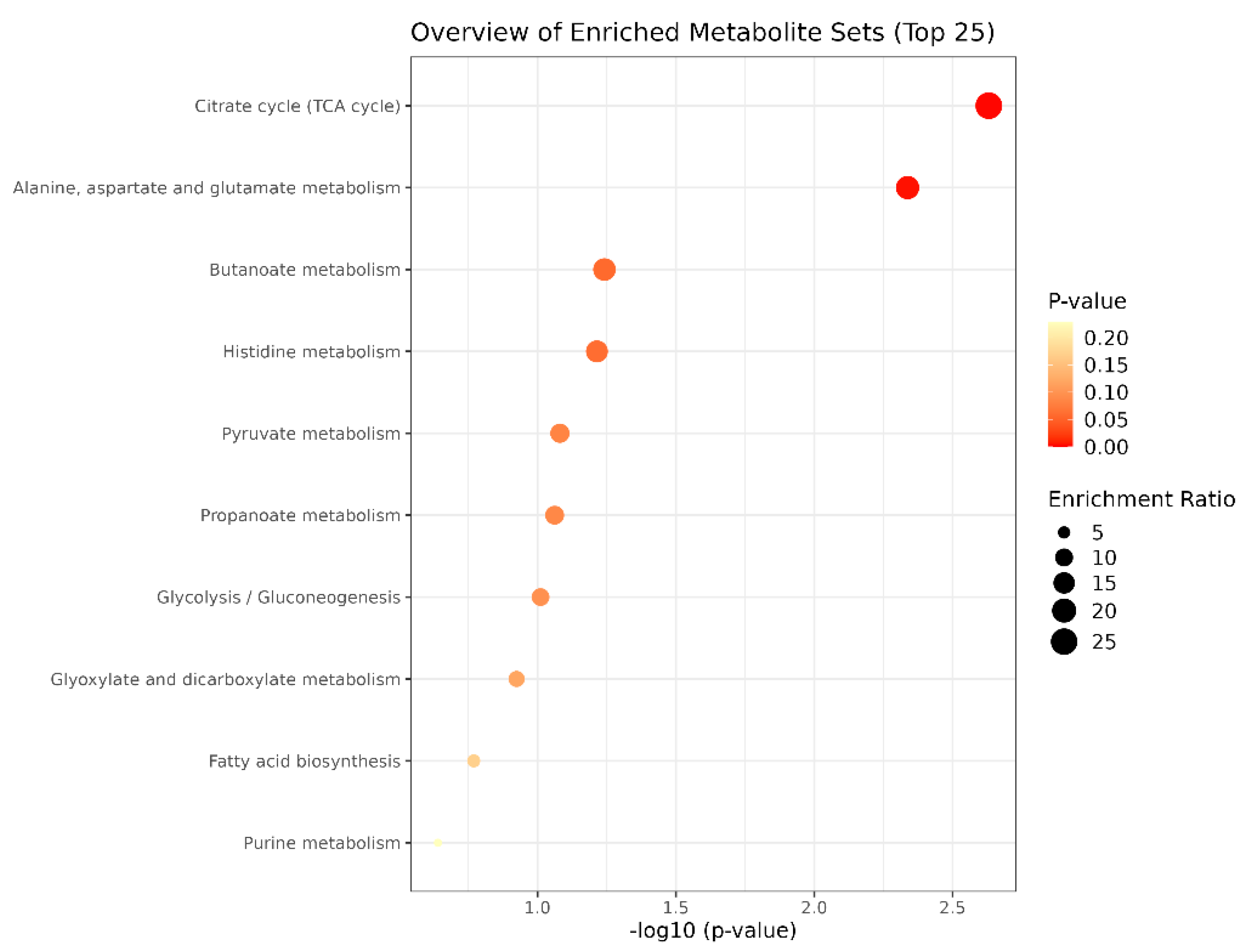
| Group | Pre-Exercise | Post-Exercise | Increase Range | Difference | t | p |
|---|---|---|---|---|---|---|
| M (n = 14) | 73.04 ± 35.12 | 79.10 ± 42.09 | 8.3% | 6.07 ± 8.76 | 2.59 | 0.022 * |
| H (n = 14) | 75.15 ± 32.69 | 97.94 ± 44.38 | 30.4% | 22.81 ± 16.12 | 5.29 | 0.000 ** |
| B (n = 14) | 72.81 ± 32.37 | 85.96 ± 40.67 | 18.1% | 13.16 ± 16.56 | 2.97 | 0.011 * |
| Group | Pre-Exercise | Post-Exercise | Increase Range | Difference | t | p |
|---|---|---|---|---|---|---|
| M (n = 14) | 53.23 ± 78.31 | 55.81 ± 79.66 | 4.8% | 2.56 ± 5.01 | 1.94 | 0.075 |
| H (n = 14) | 55.96 ± 85.77 | 60.09 ± 91.53 | 7.4% | 4.14 ± 8.55 | 1.81 | 0.094 |
| B (n = 14) | 54.77 ± 76.49 | 60.06 ± 89.27 | 9.7% | 5.30 ± 15.85 | 1.25 | 0.234 |
| Group | Pre-Exercise | Post-Exercise | Increase Range | Difference | t | p |
|---|---|---|---|---|---|---|
| M (n = 14) | 206.16 ± 222.09 | 7027.94 ± 3988.48 | 3309% | 6821.79 ± 3918.66 | 6.51 | 0.000 ** |
| H (n = 14) | 215.80 ± 235.62 | 8820.68 ± 5741.44 | 3988% | 8604.86 ± 5737.05 | 5.61 | 0.000 ** |
| B (n = 14) | 219.13 ± 190.64 | 11,205.64 ± 5607.96 | 5014% | 10,986.51 ± 5601.84 | 7.34 | 0.000 ** |
| Pre-Exercise | Post-Exercise | Increase Range | Difference | t | p | |
|---|---|---|---|---|---|---|
| M (n = 14) | 4.46 ± 1.73 | 5.11 ± 1.55 | 14.1% | 0.64 ± 1.65 | 1.49 | 0.161 |
| H (n = 14) | 4.16 ± 2.02 | 5.63 ± 1.72 | 35.1% | 1.44 ± 1.90 | 2.91 | 0.012 * |
| B (n = 14) | 4.62 ± 2.10 | 7.04 ± 1.89 | 52.4% | 2.42 ± 2.49 | 3.65 | 0.003 ** |
Disclaimer/Publisher’s Note: The statements, opinions and data contained in all publications are solely those of the individual author(s) and contributor(s) and not of MDPI and/or the editor(s). MDPI and/or the editor(s) disclaim responsibility for any injury to people or property resulting from any ideas, methods, instructions or products referred to in the content. |
© 2024 by the authors. Licensee MDPI, Basel, Switzerland. This article is an open access article distributed under the terms and conditions of the Creative Commons Attribution (CC BY) license (https://creativecommons.org/licenses/by/4.0/).
Share and Cite
Cui, X.; Anatolevna, S.T.; Wang, Y. Deciphering Blood Flow Restriction Training to Aid Lipid Lowering in Obese College Students through Untargeted Metabolomics. Metabolites 2024, 14, 433. https://doi.org/10.3390/metabo14080433
Cui X, Anatolevna ST, Wang Y. Deciphering Blood Flow Restriction Training to Aid Lipid Lowering in Obese College Students through Untargeted Metabolomics. Metabolites. 2024; 14(8):433. https://doi.org/10.3390/metabo14080433
Chicago/Turabian StyleCui, Xianyou, Sidorenko Tatiana Anatolevna, and Yu Wang. 2024. "Deciphering Blood Flow Restriction Training to Aid Lipid Lowering in Obese College Students through Untargeted Metabolomics" Metabolites 14, no. 8: 433. https://doi.org/10.3390/metabo14080433
APA StyleCui, X., Anatolevna, S. T., & Wang, Y. (2024). Deciphering Blood Flow Restriction Training to Aid Lipid Lowering in Obese College Students through Untargeted Metabolomics. Metabolites, 14(8), 433. https://doi.org/10.3390/metabo14080433






